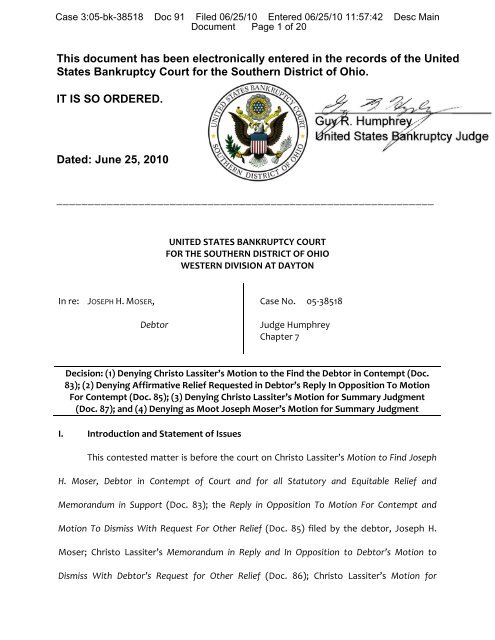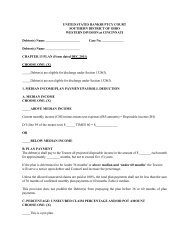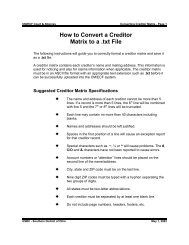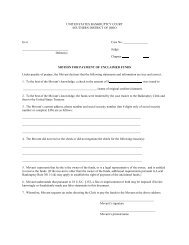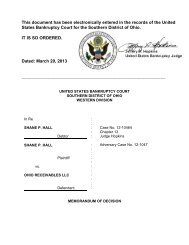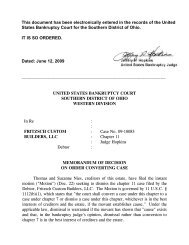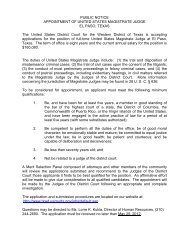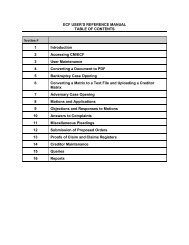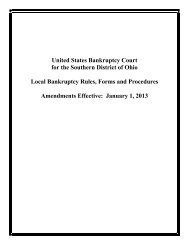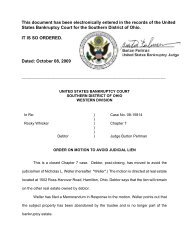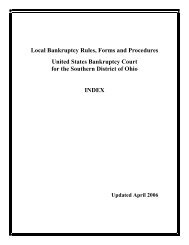This document has been electronically entered in the records of the ...
This document has been electronically entered in the records of the ...
This document has been electronically entered in the records of the ...
Create successful ePaper yourself
Turn your PDF publications into a flip-book with our unique Google optimized e-Paper software.
Case 3:05-bk-38518 Doc 91 Filed 06/25/10 Entered 06/25/10 11:57:42 Desc Ma<strong>in</strong><br />
Document Page 1 <strong>of</strong> 20<br />
<strong>This</strong> <strong>document</strong> <strong>has</strong> <strong>been</strong> <strong>electronically</strong> <strong>entered</strong> <strong>in</strong> <strong>the</strong> <strong>records</strong> <strong>of</strong> <strong>the</strong> United<br />
States Bankruptcy Court for <strong>the</strong> Sou<strong>the</strong>rn District <strong>of</strong> Ohio.<br />
IT IS SO ORDERED.<br />
Dated: June 25, 2010<br />
____________________________________________________________<br />
UNITED STATES BANKRUPTCY COURT<br />
FOR THE SOUTHERN DISTRICT OF OHIO<br />
WESTERN DIVISION AT DAYTON<br />
In re: JOSEPH H. MOSER,<br />
Debtor<br />
Case No. 05‐38518<br />
Judge Humphrey<br />
Chapter 7<br />
Decision: (1) Deny<strong>in</strong>g Christo Lassiter’s Motion to <strong>the</strong> F<strong>in</strong>d <strong>the</strong> Debtor <strong>in</strong> Contempt (Doc.<br />
83); (2) Deny<strong>in</strong>g Affirmative Relief Requested <strong>in</strong> Debtor’s Reply In Opposition To Motion<br />
For Contempt (Doc. 85); (3) Deny<strong>in</strong>g Christo Lassiter’s Motion for Summary Judgment<br />
(Doc. 87); and (4) Deny<strong>in</strong>g as Moot Joseph Moser’s Motion for Summary Judgment<br />
I. Introduction and Statement <strong>of</strong> Issues<br />
<strong>This</strong> contested matter is before <strong>the</strong> court on Christo Lassiter’s Motion to F<strong>in</strong>d Joseph<br />
H. Moser, Debtor <strong>in</strong> Contempt <strong>of</strong> Court and for all Statutory and Equitable Relief and<br />
Memorandum <strong>in</strong> Support (Doc. 83); <strong>the</strong> Reply <strong>in</strong> Opposition To Motion For Contempt and<br />
Motion To Dismiss With Request For O<strong>the</strong>r Relief (Doc. 85) filed by <strong>the</strong> debtor, Joseph H.<br />
Moser; Christo Lassiter’s Memorandum <strong>in</strong> Reply and In Opposition to Debtor’s Motion to<br />
Dismiss With Debtor’s Request for O<strong>the</strong>r Relief (Doc. 86); Christo Lassiter’s Motion for
Case 3:05-bk-38518 Doc 91 Filed 06/25/10 Entered 06/25/10 11:57:42 Desc Ma<strong>in</strong><br />
Document Page 2 <strong>of</strong> 20<br />
Summary Judgment (Doc. 87); and Petitioner’s Response to Motion for Summary Judgment<br />
and Request for Same (Doc. 88). The issues presented are: a) whe<strong>the</strong>r <strong>the</strong> debtor, Joseph H.<br />
Moser, should be held <strong>in</strong> civil contempt for referenc<strong>in</strong>g <strong>in</strong> his Bankruptcy Appellate Panel<br />
brief a letter from <strong>the</strong> Discipl<strong>in</strong>ary Counsel for <strong>the</strong> Supreme Court <strong>of</strong> Ohio which this court<br />
restricted from public access <strong>in</strong> a prior decision pursuant to 11 U.S.C. § 107(b)(2) and Federal<br />
Rule <strong>of</strong> Bankruptcy Procedure 9018 and, if so, whe<strong>the</strong>r <strong>the</strong> Debtor committed an “abuse <strong>of</strong><br />
process” <strong>in</strong> referenc<strong>in</strong>g such letter and whe<strong>the</strong>r <strong>the</strong> court should award damages or o<strong>the</strong>r<br />
relief to Lassiter as a result <strong>of</strong> that asserted contempt; and b) whe<strong>the</strong>r <strong>the</strong> court should<br />
order that “all <strong>document</strong>s purport<strong>in</strong>g to cite, quote, or o<strong>the</strong>rwise refer to <strong>the</strong> sealed<br />
<strong>document</strong> filed <strong>in</strong> this Court be sealed or appropriately redacted.” Contempt Motion, p. 11.<br />
The issues presented by Mr. Moser relate to whe<strong>the</strong>r this court should f<strong>in</strong>d Mr. Lassiter to<br />
be a “vexatious litigator” under Ohio law, and sanction or o<strong>the</strong>rwise discipl<strong>in</strong>e him for fil<strong>in</strong>g<br />
<strong>the</strong> contempt motion. For <strong>the</strong> reasons discussed below, all <strong>of</strong> <strong>the</strong> relief requested by <strong>the</strong><br />
parties to this contested matter is denied.<br />
II.<br />
Facts and Procedural Background<br />
On April 28, 2010 Christo Lassiter (“Lassiter”), appear<strong>in</strong>g pro se, filed a Motion to F<strong>in</strong>d<br />
Joseph H. Moser, Debtor <strong>in</strong> Contempt <strong>of</strong> Court and for all Statutory and Equitable Relief and<br />
Memorandum <strong>in</strong> Support (Doc. 83) (<strong>the</strong> “ Contempt Motion”). The Contempt Motion relates<br />
to a long history <strong>of</strong> legal battles among Lassiter, Joseph Moser, <strong>the</strong> debtor, (“Moser”), and<br />
Moser’s former wife, Devon Dullaghan (“Dullaghan”), formerly Devon Moser and Devon<br />
Grove‐Merritt, who also filed a Chapter 7 case <strong>in</strong> this court. <strong>This</strong> history is chronicled <strong>in</strong> prior<br />
decisions <strong>in</strong> both Moser’s and Dullaghan’s cases and <strong>in</strong> adversary proceed<strong>in</strong>gs filed <strong>in</strong><br />
2
Case 3:05-bk-38518 Doc 91 Filed 06/25/10 Entered 06/25/10 11:57:42 Desc Ma<strong>in</strong><br />
Document Page 3 <strong>of</strong> 20<br />
Dullaghan’s case. 1 The litigation <strong>in</strong> this court among Lassiter, Dullaghan, and Moser comes <strong>in</strong><br />
addition to <strong>the</strong> legal sparr<strong>in</strong>g among <strong>the</strong>se parties <strong>in</strong> o<strong>the</strong>r tribunals. 2<br />
Moser, Lassiter, and Dullaghan filed numerous <strong>document</strong>s related to <strong>the</strong> various<br />
litigation. Lassiter filed several motions seek<strong>in</strong>g to seal or strike many <strong>of</strong> <strong>the</strong> <strong>document</strong>s<br />
filed by Moser and Dullaghan. The decision address<strong>in</strong>g Lassiter’s motions to seal and to<br />
strike (<strong>the</strong> “§ 107 Decision”), and accompany<strong>in</strong>g orders can be found at Docs. 56 and 57 and<br />
<strong>in</strong> Dullaghan’s case at Docs. 100 and 101.<br />
One <strong>of</strong> <strong>the</strong> <strong>document</strong>s that <strong>the</strong> court restricted from public access pursuant to<br />
§ 107(b)(2) 3 and Federal Rule <strong>of</strong> Bankruptcy Procedure (“BR”) 9018 was a letter from <strong>the</strong><br />
Discipl<strong>in</strong>ary Counsel for <strong>the</strong> Supreme Court <strong>of</strong> Ohio notify<strong>in</strong>g Moser that <strong>the</strong> discipl<strong>in</strong>ary<br />
counsel was not proceed<strong>in</strong>g on his discipl<strong>in</strong>ary compla<strong>in</strong>t aga<strong>in</strong>st Lassiter (Doc. 19‐10 (Ex. J))<br />
(<strong>the</strong> “Restricted Letter”). While not attach<strong>in</strong>g <strong>the</strong> Restricted Letter to his appellate brief<br />
filed with <strong>the</strong> Bankruptcy Appellate Panel <strong>of</strong> <strong>the</strong> Sixth Circuit (“BAP” and <strong>the</strong> “BAP Brief”) or<br />
fil<strong>in</strong>g this <strong>document</strong> with <strong>the</strong> BAP, Moser made <strong>the</strong> follow<strong>in</strong>g statement <strong>in</strong> his BAP Brief:<br />
He [Moser] began contact<strong>in</strong>g <strong>the</strong> state Supreme Court board <strong>of</strong> discipl<strong>in</strong>ary<br />
council (sic) seek<strong>in</strong>g redress immediately <strong>in</strong> 2004 and <strong>has</strong> ma<strong>in</strong>ta<strong>in</strong>ed contact<br />
with <strong>the</strong>m and contacted o<strong>the</strong>r agencies as necessary whenever it appeared<br />
that <strong>the</strong> supreme court (sic) would not hold Lassiter accountable for his<br />
1<br />
See In re Devon Grove‐Merritt, Case No. 07‐31887, <strong>in</strong>clud<strong>in</strong>g Lassiter v. Grove‐Merritt, Adversary Proceed<strong>in</strong>g No.<br />
07‐3215, Doc. 62, and Slone v. Lassiter, Adversary Proceed<strong>in</strong>g No. 08‐3068, Doc. 70; and In re Joseph H. Moser,<br />
Case No. 05‐38518, Decision on Christo Lassiter’s Motions to Seal and Motions to Strike Records <strong>in</strong> Cases and<br />
Adversary Proceed<strong>in</strong>gs, Doc. 56.<br />
2 See Decision on Christo Lassiter’s Motions to Seal and Motions to Strike Records <strong>in</strong> Cases and Adversary<br />
Proceed<strong>in</strong>gs, Doc. 56, p. 3, fn. 1 for a description <strong>of</strong> <strong>the</strong> various litigation <strong>in</strong>volv<strong>in</strong>g Lassiter, Dullaghan, and<br />
Moser and <strong>the</strong>ir relationships filed <strong>in</strong> o<strong>the</strong>r courts.<br />
3 Unless o<strong>the</strong>rwise noted, all statutory references are to <strong>the</strong> Bankruptcy Code <strong>of</strong> 1978, as amended, 11 U.S.C.<br />
§§ 101‐1532 (<strong>the</strong> “Code”), cited here<strong>in</strong>after <strong>in</strong> this decision as “§ ___”.<br />
3
Case 3:05-bk-38518 Doc 91 Filed 06/25/10 Entered 06/25/10 11:57:42 Desc Ma<strong>in</strong><br />
Document Page 4 <strong>of</strong> 20<br />
misconduct despite <strong>the</strong> fact that <strong>the</strong>y believed <strong>the</strong> allegations were “probably<br />
true.”<br />
Contempt Motion, p. 3.<br />
Lassiter first sought relief with <strong>the</strong> BAP regard<strong>in</strong>g Moser’s statement <strong>in</strong> his BAP Brief,<br />
by fil<strong>in</strong>g a motion seek<strong>in</strong>g to hold Moser <strong>in</strong> contempt. The BAP <strong>entered</strong> an Order on April 22,<br />
2010 deny<strong>in</strong>g <strong>the</strong> motion before it without prejudice, stat<strong>in</strong>g that “<strong>in</strong> <strong>the</strong> <strong>in</strong>terest <strong>of</strong> judicial<br />
efficiency, a motion seek<strong>in</strong>g contempt should first be brought before <strong>the</strong> court issu<strong>in</strong>g <strong>the</strong><br />
order which <strong>has</strong> allegedly <strong>been</strong> violated.” Accord<strong>in</strong>gly, Lassiter filed <strong>the</strong> Contempt Motion<br />
with this court. Lassiter requests this court to f<strong>in</strong>d Moser “<strong>in</strong> contempt <strong>of</strong> Court and for all<br />
statutory and equitable relief for publically cit<strong>in</strong>g to and quot<strong>in</strong>g a <strong>document</strong> sealed by this<br />
Court.” Contempt Motion, p. 2. The specific relief which Lassiter is request<strong>in</strong>g is:<br />
1) That Joseph H. Moser be found <strong>in</strong> contempt <strong>of</strong> court for violat<strong>in</strong>g<br />
bankruptcy court orders published as Docs (57) and (70) and for abuse <strong>of</strong><br />
process by us<strong>in</strong>g litigation <strong>in</strong> this court to cont<strong>in</strong>ue publication <strong>in</strong> violation <strong>of</strong><br />
Rule V 11 (E)(1) <strong>of</strong> Rules <strong>of</strong> Governance for <strong>the</strong> Supreme Court <strong>of</strong> Ohio;<br />
2) That Joseph H. Moser be ordered to pay to Christo Lassiter an amount<br />
equal to or greater than <strong>the</strong> $5,137.50 plus statutory <strong>in</strong>terest awarded to him<br />
by <strong>the</strong> bankruptcy court;<br />
3) That all <strong>document</strong>s purport<strong>in</strong>g to cite, quote, or o<strong>the</strong>rwise refer to <strong>the</strong><br />
sealed <strong>document</strong> filed <strong>in</strong> this Court be sealed or appropriately redacted. Such<br />
<strong>document</strong>s <strong>in</strong>clude: this motion, replies and related fil<strong>in</strong>gs.<br />
Contempt Motion, p. 11.<br />
On May 14, 2010 Moser filed his Reply <strong>in</strong> Opposition To Motion For Contempt and<br />
Motion To Dismiss With Request For O<strong>the</strong>r Relief (Doc. 85) (<strong>the</strong> “Objection”). In addition to<br />
oppos<strong>in</strong>g <strong>the</strong> relief sought by Lassiter, Moser also requested that this court f<strong>in</strong>d Lassiter to<br />
be a vexatious litigator, sanction and/or discipl<strong>in</strong>e him for fil<strong>in</strong>g <strong>the</strong> Contempt Motion.<br />
4
Case 3:05-bk-38518 Doc 91 Filed 06/25/10 Entered 06/25/10 11:57:42 Desc Ma<strong>in</strong><br />
Document Page 5 <strong>of</strong> 20<br />
Lassiter filed his reply to Moser’s Objection (Doc. 86) and a separate motion seek<strong>in</strong>g<br />
summary judgment (Doc. 87) on May 23, 2010. On June 4, 2010 Moser filed Petitioner’s<br />
Response to Motion for Summary Judgment and Request for Same (Doc. 88) oppos<strong>in</strong>g<br />
Lassiter’s motion for summary judgment and request<strong>in</strong>g summary judgment <strong>in</strong> his favor.<br />
III.<br />
Legal Analysis<br />
A. Jurisdiction<br />
The court <strong>has</strong> jurisdiction over <strong>the</strong>se matters and proceed<strong>in</strong>gs pursuant to 28 U.S.C.<br />
§§ 157(a) and 1334, and <strong>the</strong> stand<strong>in</strong>g General Order <strong>of</strong> Reference <strong>in</strong> this District. <strong>This</strong><br />
contested matter is a core proceed<strong>in</strong>g by virtue <strong>of</strong> 28 U.S.C. § 157(b)(2)(A) and (O).<br />
orders.<br />
B. Moser’s Reference to <strong>the</strong> Letter Restricted From Public Access Does<br />
Not Constitute Contempt <strong>of</strong> Any Order <strong>of</strong> <strong>This</strong> Court and, Therefore,<br />
<strong>the</strong> Relief Requested <strong>in</strong> <strong>the</strong> Contempt Motion (Doc. 83) and <strong>in</strong><br />
Lassiter’s Motion for Summary Judgment is Denied<br />
Moser’s reference to <strong>the</strong> Restricted Letter does not constitute contempt <strong>of</strong> those<br />
Bankruptcy courts have authority to issue contempt sanctions and to issue o<strong>the</strong>r<br />
orders that may be appropriate to enforce <strong>the</strong>ir orders and court rules. Section 105(a)<br />
provides that:<br />
The court may issue any order, process, or judgment that is necessary or<br />
appropriate to carry out <strong>the</strong> provisions <strong>of</strong> this title. No provision <strong>of</strong> this title<br />
provid<strong>in</strong>g for <strong>the</strong> rais<strong>in</strong>g <strong>of</strong> an issue by a party <strong>in</strong> <strong>in</strong>terest shall be construed to<br />
preclude <strong>the</strong> court from, sua sponte, tak<strong>in</strong>g any action or mak<strong>in</strong>g any<br />
determ<strong>in</strong>ation necessary or appropriate to enforce or implement court<br />
orders or rules, or to prevent an abuse <strong>of</strong> process.<br />
11 U.S.C. § 105(a) (bold added). The Sixth Circuit <strong>has</strong> recognized that bankruptcy courts have<br />
contempt powers under § 105(a). Pertuso v. Ford Motor Credit Co., 233 F.3d 417, 423 (6th Cir.<br />
5
Case 3:05-bk-38518 Doc 91 Filed 06/25/10 Entered 06/25/10 11:57:42 Desc Ma<strong>in</strong><br />
Document Page 6 <strong>of</strong> 20<br />
2000) (Section 105 undoubtedly vests bankruptcy courts with statutory contempt powers,<br />
but it "does not authorize <strong>the</strong> bankruptcy courts to create substantive rights that are<br />
o<strong>the</strong>rwise unavailable under applicable law . . . ." (citations omitted)).<br />
While Lassiter does not specify what type <strong>of</strong> contempt he is pursu<strong>in</strong>g, it appears that<br />
he wants <strong>the</strong> court to hold Moser <strong>in</strong> civil contempt <strong>of</strong> orders <strong>entered</strong> on September 2, 2009<br />
and November 3, 2009 (Docs. 57 and 70). Contempt can be civil or crim<strong>in</strong>al. Whe<strong>the</strong>r a<br />
particular proceed<strong>in</strong>g is one <strong>of</strong> civil or crim<strong>in</strong>al contempt depends upon <strong>the</strong> purpose <strong>of</strong> <strong>the</strong><br />
proceed<strong>in</strong>g and <strong>the</strong> potential sanction to be imposed if contempt is found. The purpose <strong>of</strong> a<br />
crim<strong>in</strong>al contempt proceed<strong>in</strong>g “is punitive ‐‐ ‘to v<strong>in</strong>dicate <strong>the</strong> authority <strong>of</strong> <strong>the</strong> court.’”<br />
United States v. Bayshore Assocs., Inc., 934 F.2d 1391, 1400 (6th Cir. 1991), cit<strong>in</strong>g Gompers v.<br />
Buck’s Stove & Range Co., 221 U.S. 418, 441 (1911). Conversely, <strong>the</strong> purpose <strong>of</strong> civil contempt<br />
is “to coerce <strong>the</strong> defendant <strong>in</strong>to compliance with <strong>the</strong> court’s order, and to compensate <strong>the</strong><br />
compla<strong>in</strong>ant for losses susta<strong>in</strong>ed.” Id. See also Glover v. Johnson, 199 F.3d 310, 313 (6th Cir.<br />
1999). In his prayer for relief Lassiter requests, among o<strong>the</strong>r relief, “[t]hat Joseph H. Moser<br />
be ordered to pay to Christo Lassiter an amount equal to or greater than <strong>the</strong> $5,137.50 plus<br />
statutory <strong>in</strong>terest awarded to him by <strong>the</strong> bankruptcy court” and “[t]hat all <strong>document</strong>s<br />
purport<strong>in</strong>g to cite, quote, or o<strong>the</strong>rwise refer to <strong>the</strong> sealed <strong>document</strong> filed <strong>in</strong> this Court be<br />
sealed or appropriately redacted.” Contempt Motion, p. 11.<br />
Thus, <strong>the</strong> purpose <strong>of</strong> this<br />
proceed<strong>in</strong>g is to coerce Moser <strong>in</strong>to compliance with this court’s orders and to compensate<br />
Lassiter for losses he <strong>has</strong> susta<strong>in</strong>ed. Therefore, it is civil and not crim<strong>in</strong>al <strong>in</strong> nature.<br />
In order to prevail <strong>in</strong> a civil contempt proceed<strong>in</strong>g, <strong>the</strong> mov<strong>in</strong>g party must establish by<br />
clear and conv<strong>in</strong>c<strong>in</strong>g evidence that <strong>the</strong> respondent violated a prior court order. Liberte<br />
6
Case 3:05-bk-38518 Doc 91 Filed 06/25/10 Entered 06/25/10 11:57:42 Desc Ma<strong>in</strong><br />
Document Page 7 <strong>of</strong> 20<br />
Capital Group, LLC v. Capwill, 462 F.3d 543, 550‐51 (6th Cir. 2006); Glover, 199 F.3d at 707. The<br />
order alleged to have <strong>been</strong> violated must be “clear and unambiguous” and <strong>the</strong> movant must<br />
establish that <strong>the</strong> respondent “violated a def<strong>in</strong>ite and specific order <strong>of</strong> <strong>the</strong> court requir<strong>in</strong>g<br />
him to perform or refra<strong>in</strong> from perform<strong>in</strong>g a particular act or acts with knowledge <strong>of</strong> <strong>the</strong><br />
court’s order.” Liberte, 462 F.3d at 550.<br />
The purpose <strong>of</strong> an order under § 107(b)(2), such as <strong>the</strong> orders <strong>in</strong> question, is to<br />
“protect a person with respect to scandalous or defamatory matter conta<strong>in</strong>ed <strong>in</strong> a paper<br />
filed <strong>in</strong> a case under this title.” 11 U.S.C. § 107(b)(2). BR 9018 implements § 107(b)(2) by<br />
provid<strong>in</strong>g that “<strong>the</strong> court may make any order which justice requires . . . (2) to protect any<br />
entity aga<strong>in</strong>st scandalous or defamatory matter conta<strong>in</strong>ed <strong>in</strong> any paper filed <strong>in</strong> a case under<br />
<strong>the</strong> Code[.]”<br />
The court determ<strong>in</strong>ed that <strong>the</strong> Restricted Letter that Moser referenced <strong>in</strong> <strong>the</strong> BAP<br />
Brief, <strong>in</strong> addition to a number <strong>of</strong> o<strong>the</strong>r exhibits filed <strong>in</strong> support <strong>of</strong>, or <strong>in</strong> opposition to,<br />
Moser’s and Dullaghan’s motions request<strong>in</strong>g <strong>the</strong> court to f<strong>in</strong>d that Lassiter violated<br />
Dullaghan’s bankruptcy stay and Moser’s and Dullaghan’s discharge <strong>in</strong>junctions, was<br />
“scandalous” with<strong>in</strong> <strong>the</strong> mean<strong>in</strong>g <strong>of</strong> § 107(b)(2) “[b]ecause <strong>the</strong> parties agree that <strong>the</strong>se<br />
<strong>document</strong>s are irrelevant and have withdrawn those exhibits, many <strong>of</strong> <strong>the</strong>se <strong>document</strong>s<br />
conta<strong>in</strong> personal <strong>in</strong>formation for which <strong>the</strong> public <strong>has</strong> no legitimate need for access, and <strong>the</strong><br />
<strong>document</strong>s conta<strong>in</strong> material that could be harmful to <strong>the</strong> parties’ reputations[.]” § 107<br />
Decision, Doc. 56, p. 33. Accord<strong>in</strong>gly, <strong>the</strong> court ordered <strong>the</strong> letter restricted from public<br />
access. Specifically, <strong>the</strong> court found and ordered that:<br />
In accordance with <strong>the</strong> simultaneously filed Decision on Christo Lassiter’s<br />
Motion to Seal and Motions to Strike Records <strong>in</strong> Cases and Adversary<br />
7
Case 3:05-bk-38518 Doc 91 Filed 06/25/10 Entered 06/25/10 11:57:42 Desc Ma<strong>in</strong><br />
Document Page 8 <strong>of</strong> 20<br />
Proceed<strong>in</strong>gs, <strong>the</strong> court FINDS that Movants’ Dullaghan’s and Moser’s Jo<strong>in</strong>t<br />
Exhibits 2, 7, 11, 13‐16, 18‐22, and 26‐27 and Respondent’s Lassiter’s Exhibits N,<br />
P, Q, R, S, T, U, V, W, X and Y filed <strong>in</strong> connection with <strong>the</strong> hear<strong>in</strong>g on <strong>the</strong><br />
Motion for Contempt (Doc. 19) are scandalous under 11 U.S.C. § 107(b)(2) and<br />
shall cont<strong>in</strong>ue to be restricted from public access pursuant to Federal Rules <strong>of</strong><br />
Bankruptcy Procedure 9018 and 9037(d).<br />
Order on Decision on Christo Lassiter’s Motions to Seal and Motions to Strike Records <strong>in</strong> Cases<br />
and Adversary Proceed<strong>in</strong>gs, p. 1 (Doc. 57). While not restrict<strong>in</strong>g access to all <strong>of</strong> <strong>the</strong> fil<strong>in</strong>gs<br />
requested by Lassiter, <strong>the</strong> § 107 Decision did restrict public access to certa<strong>in</strong> <strong>document</strong>s<br />
found to be scandalous under § 107(b)(2), <strong>in</strong>clud<strong>in</strong>g <strong>the</strong> Restricted Letter referenced <strong>in</strong><br />
Moser’s BAP Brief.<br />
The orders on <strong>the</strong> § 107 Decision do not order Moser to refra<strong>in</strong> from publish<strong>in</strong>g,<br />
discuss<strong>in</strong>g, or us<strong>in</strong>g any <strong>document</strong> or <strong>in</strong>formation <strong>in</strong> any court fil<strong>in</strong>g, <strong>in</strong> any o<strong>the</strong>r forum or<br />
through any o<strong>the</strong>r means. Therefore, <strong>in</strong> comment<strong>in</strong>g on <strong>the</strong> Restricted Letter <strong>in</strong> his BAP<br />
Brief, Moser did not violate any order <strong>of</strong> this court. Moser correctly notes that <strong>the</strong> § 107<br />
Decision and accompany<strong>in</strong>g orders only direct court employees to take or refra<strong>in</strong> from<br />
action – specifically those orders require <strong>the</strong> court to restrict those <strong>document</strong>s from public<br />
access.<br />
Accord<strong>in</strong>gly, <strong>the</strong> court does not f<strong>in</strong>d that Moser’s conduct <strong>in</strong> referenc<strong>in</strong>g <strong>the</strong><br />
Restricted Letter “violated a def<strong>in</strong>ite and specific order <strong>of</strong> <strong>the</strong> court requir<strong>in</strong>g him to<br />
perform or refra<strong>in</strong> from perform<strong>in</strong>g a particular act or acts with knowledge <strong>of</strong> <strong>the</strong> court’s<br />
order.” Liberte, 462 F.3d at 550‐51. The court f<strong>in</strong>ds as a matter <strong>of</strong> law that Moser’s conduct<br />
<strong>in</strong> referenc<strong>in</strong>g <strong>the</strong> Restricted Letter did not violate <strong>the</strong> court’s clear and specific orders. For<br />
this reason, Lassiter’s requests for an order f<strong>in</strong>d<strong>in</strong>g Moser <strong>in</strong> contempt and for summary<br />
judgment are denied. In addition, because Lassiter’s damages are requested as part <strong>of</strong> his<br />
8
Case 3:05-bk-38518 Doc 91 Filed 06/25/10 Entered 06/25/10 11:57:42 Desc Ma<strong>in</strong><br />
Document Page 9 <strong>of</strong> 20<br />
contempt citation, that request is also denied s<strong>in</strong>ce <strong>the</strong> court f<strong>in</strong>ds as a matter <strong>of</strong> law that no<br />
civil contempt <strong>has</strong> occurred. 4<br />
The second prong <strong>of</strong> Lassiter’s request to hold Moser <strong>in</strong> civil contempt ‐‐ that this<br />
court f<strong>in</strong>d that such alleged contempt also constitutes an “abuse <strong>of</strong> process” ‐‐ is also<br />
denied. Lassiter framed his request for an “abuse <strong>of</strong> process” f<strong>in</strong>d<strong>in</strong>g <strong>in</strong> <strong>the</strong> context <strong>of</strong><br />
contempt as follows: “[t]hat Joseph H. Moser be found <strong>in</strong> contempt <strong>of</strong> court for violat<strong>in</strong>g<br />
bankruptcy court orders published as Docs (57) and (70) and for abuse <strong>of</strong> process by us<strong>in</strong>g<br />
litigation <strong>in</strong> this court to cont<strong>in</strong>ue publication <strong>in</strong> violation <strong>of</strong> Rule V 11 (E)(1) <strong>of</strong> Rules <strong>of</strong><br />
Governance for <strong>the</strong> Supreme Court <strong>of</strong> Ohio[.]” Contempt Motion, p. 11, emp<strong>has</strong>is added.<br />
Therefore, this court is constru<strong>in</strong>g such request as part <strong>of</strong> Lassiter’s request for a contempt<br />
citation and not as an <strong>in</strong>dependent claim for “abuse <strong>of</strong> process.” 5 Fur<strong>the</strong>rmore, this court is<br />
not <strong>the</strong> proper forum for determ<strong>in</strong><strong>in</strong>g whe<strong>the</strong>r one <strong>of</strong> <strong>the</strong> Ohio Rules for <strong>the</strong> Government <strong>of</strong><br />
<strong>the</strong> Bar was violated. 6<br />
Thus, hav<strong>in</strong>g found no contempt <strong>of</strong> court and this court not be<strong>in</strong>g <strong>the</strong><br />
4 As noted by <strong>the</strong> BAP, Lassiter does not provide an explanation for <strong>the</strong> $5,137.50 <strong>in</strong> damages that he seeks.<br />
<strong>This</strong> figure is, however, precisely <strong>the</strong> same amount <strong>of</strong> damages awarded to Moser on account <strong>of</strong> <strong>the</strong> court’s<br />
f<strong>in</strong>d<strong>in</strong>g that Lassiter violated Moser’s discharge <strong>in</strong>junction. See Doc. 64. Even if this court found Moser <strong>in</strong><br />
contempt, it would deny <strong>the</strong> award <strong>of</strong> damages to Lassiter <strong>in</strong> this amount s<strong>in</strong>ce Lassiter <strong>has</strong> not provided <strong>the</strong><br />
court with any basis for such an award <strong>of</strong> damages. Damages for civil contempt are <strong>in</strong>tended to compensate<br />
<strong>the</strong> party for <strong>the</strong> <strong>in</strong>jury <strong>in</strong>curred as a result <strong>of</strong> <strong>the</strong> contempt. Lassiter <strong>has</strong> not expla<strong>in</strong>ed how he <strong>has</strong> <strong>been</strong><br />
damaged <strong>in</strong> <strong>the</strong> amount <strong>of</strong> $5,137.50 by Moser’s alleged contempt <strong>of</strong> this court’s orders.<br />
5 The Sixth Circuit <strong>has</strong> not ruled on whe<strong>the</strong>r <strong>the</strong>re is a separate federally recognized claim for abuse <strong>of</strong> process.<br />
See Voyticky v. Village <strong>of</strong> Timberlake, 412 F.3d 669, 676‐77 (6th Cir. 2005).<br />
6 The court believes that <strong>the</strong>re are questions as to <strong>the</strong> validity <strong>of</strong> <strong>the</strong> premise upon which Lassiter bases his<br />
abuse <strong>of</strong> process allegation ‐‐ that Moser published <strong>in</strong>formation concern<strong>in</strong>g an Ohio attorney discipl<strong>in</strong>ary<br />
grievance <strong>in</strong>vestigation <strong>in</strong> violation <strong>of</strong> <strong>the</strong> Ohio Rules for <strong>the</strong> Government <strong>of</strong> <strong>the</strong> Bar – <strong>in</strong>clud<strong>in</strong>g:<br />
a) whe<strong>the</strong>r <strong>the</strong>se Rules apply to Moser s<strong>in</strong>ce at no time <strong>has</strong> it <strong>been</strong> represented <strong>in</strong> <strong>the</strong>se proceed<strong>in</strong>gs that<br />
Moser is an Ohio attorney subject to those Rules. In this regard <strong>the</strong> court notes that Lassiter refers to <strong>the</strong>se<br />
Rules as <strong>the</strong> “Rules <strong>of</strong> Governance for <strong>the</strong> Supreme Court <strong>of</strong> Ohio” (See Contempt Motion, p. 4, 6 and p. 10);<br />
however, it appears that he is referr<strong>in</strong>g to <strong>the</strong> Rules for <strong>the</strong> Government <strong>of</strong> <strong>the</strong> Bar <strong>of</strong> Ohio. See Gov. Bar R XX:<br />
“These rules shall be known as <strong>the</strong> Supreme Court Rules for <strong>the</strong> Government <strong>of</strong> <strong>the</strong> Bar <strong>of</strong> Ohio and shall be<br />
cited as “Gov. Bar. R. _.” ; and b) whe<strong>the</strong>r <strong>the</strong> provision cited by Lassiter only governs <strong>the</strong> conduct <strong>of</strong> those<br />
9
Case 3:05-bk-38518 Doc 91 Filed 06/25/10 Entered 06/25/10 11:57:42 Desc Ma<strong>in</strong><br />
Document Page 10 <strong>of</strong> 20<br />
proper forum for determ<strong>in</strong><strong>in</strong>g whe<strong>the</strong>r one <strong>of</strong> <strong>the</strong> Ohio Rules for <strong>the</strong> Government <strong>of</strong> <strong>the</strong> Bar<br />
was violated, <strong>the</strong> court decl<strong>in</strong>es to f<strong>in</strong>d any abuse <strong>of</strong> process as asserted by Lassiter as part<br />
<strong>of</strong> his contempt allegations.<br />
C. Lassiter’s Request for an Order Seal<strong>in</strong>g or Redact<strong>in</strong>g References<br />
to <strong>the</strong> Letter Restricted From Public Access Is Denied<br />
In addition to request<strong>in</strong>g a contempt citation aga<strong>in</strong>st Moser, Lassiter <strong>has</strong> also asked<br />
that “all <strong>document</strong>s purport<strong>in</strong>g to cite, quote, or o<strong>the</strong>rwise refer to <strong>the</strong> sealed <strong>document</strong><br />
filed <strong>in</strong> this Court be sealed or appropriately redacted. Such <strong>document</strong>s <strong>in</strong>clude: this motion,<br />
replies and related fil<strong>in</strong>gs.” Contempt Motion, p. 11. The request is denied.<br />
The court detailed its ability to issue orders protect<strong>in</strong>g parties from filed <strong>document</strong>s<br />
and <strong>in</strong>formation <strong>in</strong> those <strong>document</strong>s <strong>in</strong> <strong>the</strong> § 107 Decision. The § 107 Decision is <strong>in</strong>corporated<br />
by reference. Certa<strong>in</strong> pr<strong>in</strong>ciples set forth <strong>in</strong> <strong>the</strong> § 107 Decision are appropriate to repeat <strong>in</strong><br />
this Decision <strong>in</strong> response to Lassiter’s request for a protective order. First, <strong>the</strong> general rule is<br />
that <strong>records</strong> filed with a bankruptcy court are to be open to <strong>the</strong> public for <strong>in</strong>spection and<br />
copy<strong>in</strong>g. See § 107 Decision, pp. 13‐14. Only when an extraord<strong>in</strong>ary circumstance or a<br />
compell<strong>in</strong>g need is present is <strong>the</strong> public’s access to <strong>document</strong>s filed with <strong>the</strong> court to be<br />
restricted. Id. Second, matters that are relevant to <strong>the</strong> contested matter generally are not<br />
restricted from public access even if <strong>the</strong>y are <strong>of</strong>fensive to <strong>the</strong> movant. § 107 Decision, p. 19.<br />
Lassiter requested that <strong>the</strong> court f<strong>in</strong>d Moser <strong>in</strong> contempt for referenc<strong>in</strong>g <strong>the</strong><br />
Restricted Letter and issue an order restrict<strong>in</strong>g <strong>the</strong> public’s access to references to <strong>the</strong><br />
letter. Redact<strong>in</strong>g or o<strong>the</strong>rwise remov<strong>in</strong>g that reference from <strong>the</strong> public record will prevent<br />
<strong>in</strong>volved <strong>in</strong> adjudicat<strong>in</strong>g lawyer grievances filed <strong>in</strong> Ohio, such as grievance committees, boards, and counsel.<br />
See Ohio Rules for <strong>the</strong> Government <strong>of</strong> <strong>the</strong> Bar, Rule V, Section 11 (E)(1) and (2)(c).<br />
10
Case 3:05-bk-38518 Doc 91 Filed 06/25/10 Entered 06/25/10 11:57:42 Desc Ma<strong>in</strong><br />
Document Page 11 <strong>of</strong> 20<br />
<strong>the</strong> public from be<strong>in</strong>g able to scrut<strong>in</strong>ize this court’s actions to ensure <strong>the</strong> <strong>in</strong>tegrity <strong>of</strong> this<br />
court and also could potentially make any appellate review more difficult. See § 107 Decision,<br />
pp. 13‐14.<br />
Situations may occur <strong>in</strong> which restrict<strong>in</strong>g public access to <strong>in</strong>formation <strong>in</strong> a brief or<br />
o<strong>the</strong>r fil<strong>in</strong>g would be appropriate even though that <strong>in</strong>formation may be relevant to <strong>the</strong><br />
court’s determ<strong>in</strong>ation. For example, a party’s <strong>in</strong>clusion <strong>of</strong> <strong>in</strong>appropriate material <strong>in</strong> a fil<strong>in</strong>g<br />
which compels ano<strong>the</strong>r party’s fil<strong>in</strong>g <strong>of</strong> a protective motion would, under those<br />
circumstances, render that reference relevant to <strong>the</strong> court’s determ<strong>in</strong>ation even though <strong>the</strong><br />
only basis for <strong>the</strong> relevancy may be that a party made an <strong>in</strong>appropriate fil<strong>in</strong>g or reference.<br />
Thus, under such circumstances, it may be proper to restrict <strong>the</strong> public’s access to such a<br />
<strong>document</strong> or from <strong>the</strong> <strong>of</strong>fend<strong>in</strong>g reference or provision <strong>of</strong> <strong>the</strong> <strong>document</strong>. However, this is<br />
not <strong>the</strong> case <strong>in</strong> this matter. As noted previously, this contested matter is just ano<strong>the</strong>r<br />
chapter <strong>in</strong> <strong>the</strong> litigation saga among Lassiter, Moser, and Dullaghan. See footnotes 1 and 2.<br />
The accusations among <strong>the</strong> parties have <strong>been</strong> rampant. Allegations may be “so vague and<br />
so grossly volum<strong>in</strong>ous as to tax <strong>the</strong> credulity <strong>of</strong> anyone exam<strong>in</strong><strong>in</strong>g <strong>the</strong> files.” § 107 Decision<br />
at p. 17, quot<strong>in</strong>g In re Sherman‐Noyes & Prairie Apartments Real Estate Inv. P’ship, 59 B.R. 905,<br />
909 (Bankr. N.D. Ill. 1986). The accusations widely broadcasted by Lassiter, Moser, and<br />
Dullaghan <strong>in</strong> <strong>the</strong> litigation pursued <strong>in</strong> <strong>the</strong> various forums fall <strong>in</strong>to that category.<br />
Fur<strong>the</strong>rmore, as mentioned above, <strong>the</strong> primary premise upon which Lassiter asserts that<br />
references to <strong>the</strong> Restricted Letter should be sealed – that Ohio’s Rules for <strong>the</strong> Government<br />
<strong>of</strong> <strong>the</strong> Bar prohibit Moser’s disclosure <strong>of</strong> such <strong>in</strong>formation – may not be supportable.<br />
11
Case 3:05-bk-38518 Doc 91 Filed 06/25/10 Entered 06/25/10 11:57:42 Desc Ma<strong>in</strong><br />
Document Page 12 <strong>of</strong> 20<br />
Accord<strong>in</strong>gly, s<strong>in</strong>ce <strong>the</strong> reference to <strong>the</strong> Restricted Letter is relevant to rul<strong>in</strong>g on<br />
Lassiter’s contempt motion and for <strong>the</strong> o<strong>the</strong>r reasons discussed, <strong>the</strong> court decl<strong>in</strong>es to issue<br />
an order restrict<strong>in</strong>g any <strong>document</strong>s from public access or order<strong>in</strong>g that any <strong>document</strong>s be<br />
redacted to delete references to <strong>the</strong> Restricted Letter.<br />
Unless some o<strong>the</strong>r tribunal,<br />
<strong>in</strong>clud<strong>in</strong>g <strong>the</strong> BAP or an appropriate Ohio authority, directs that Moser’s references to <strong>the</strong><br />
Restricted Letter be redacted or restricted from public access, this court decl<strong>in</strong>es to do so<br />
and denies Lassiter’s request to seal or redact <strong>the</strong> pert<strong>in</strong>ent <strong>document</strong>s and references. 7<br />
D. The Affirmative Relief Requested by Moser In His Reply (Doc. 85) Is Denied<br />
In his Reply, Moser requests that Lassiter be found a vexatious litigator, an issue<br />
previously raised by Moser. 8 For essentially <strong>the</strong> same reasons as those <strong>the</strong> court relied upon<br />
to deny those prior sanction requests, Moser’s pleas to f<strong>in</strong>d Lassiter to be a “vexatious<br />
litigator” under Ohio law, sanction him, and discipl<strong>in</strong>e him under <strong>the</strong> applicable rules<br />
govern<strong>in</strong>g attorneys before this court are also denied.<br />
1. Vexatious Litigator Request<br />
The court denies Moser’s request for an order f<strong>in</strong>d<strong>in</strong>g Lassiter a vexatious litigator<br />
under Ohio’s vexatious litigator statute, ORC § 2323.52, on <strong>the</strong> basis <strong>of</strong> <strong>the</strong> law <strong>of</strong> <strong>the</strong> case<br />
doctr<strong>in</strong>e, for lack <strong>of</strong> jurisdiction, and also as be<strong>in</strong>g procedurally improper.<br />
First, <strong>the</strong> vexatious litigator claim is denied on <strong>the</strong> basis <strong>of</strong> law <strong>of</strong> <strong>the</strong> case doctr<strong>in</strong>e.<br />
Issues decided at an early stage <strong>of</strong> <strong>the</strong> litigation, ei<strong>the</strong>r explicitly or by necessary <strong>in</strong>ference<br />
7 To be clear, <strong>the</strong> Restricted Letter shall cont<strong>in</strong>ue to be restricted from public access; however, <strong>the</strong> court is not<br />
restrict<strong>in</strong>g from public access <strong>the</strong> reference to <strong>the</strong> Restricted Letter <strong>in</strong> <strong>the</strong> fil<strong>in</strong>gs <strong>in</strong> this court relat<strong>in</strong>g to <strong>the</strong><br />
Contempt Motion.<br />
8 See Order Grant<strong>in</strong>g <strong>in</strong> Part and Deny<strong>in</strong>g <strong>in</strong> Part Respondent’s Motion to Dismiss <strong>entered</strong> on June 25, 2009 as Doc.<br />
90 <strong>in</strong> Case No. 07‐31887 (In re Devon Grove‐Merritt).<br />
12
Case 3:05-bk-38518 Doc 91 Filed 06/25/10 Entered 06/25/10 11:57:42 Desc Ma<strong>in</strong><br />
Document Page 13 <strong>of</strong> 20<br />
from <strong>the</strong> disposition, constitute law <strong>of</strong> <strong>the</strong> case. Brady‐Morris v. Schill<strong>in</strong>g (In re Kenneth Allen<br />
Knight Trust), 303 F.3d 671, 676 (6th Cir. 2002). The law <strong>of</strong> <strong>the</strong> case doctr<strong>in</strong>e is “directed to a<br />
court's common sense” and is not an “<strong>in</strong>exorable command,” and precludes a court from<br />
reconsideration <strong>of</strong> identical issues. Hanover Ins. Co. v. American Eng'g Co., 105 F.3d 306, 312<br />
(6th Cir. 1997).<br />
The three exceptional reasons that courts have held to justify<br />
reconsideration <strong>of</strong> previously decided issues are: “(1) where substantially different evidence<br />
is raised on subsequent trial; (2) where a subsequent contrary view <strong>of</strong> <strong>the</strong> law is decided by<br />
<strong>the</strong> controll<strong>in</strong>g authority; or (3) where a decision is clearly erroneous and would work a<br />
manifest <strong>in</strong>justice.” Id. (citations omitted); see also United States v. Rayborn, 495 F.3d 328,<br />
337 (6th Cir. 2007). Moser <strong>has</strong> not described an exceptional circumstance justify<strong>in</strong>g <strong>the</strong><br />
court’s reconsideration <strong>of</strong> its prior decision f<strong>in</strong>d<strong>in</strong>g that it did not have jurisdiction over his<br />
vexatious litigator claim aga<strong>in</strong>st Lassiter.<br />
Accord<strong>in</strong>gly, <strong>the</strong> court’s earlier rul<strong>in</strong>g on <strong>the</strong><br />
vexatious litigator claim is law <strong>of</strong> <strong>the</strong> case. However, s<strong>in</strong>ce that decision was announced<br />
orally, <strong>the</strong> court will reiterate its basis for conclud<strong>in</strong>g that it does not have jurisdiction over<br />
such a claim.<br />
Bankruptcy courts are courts <strong>of</strong> limited jurisdiction and not courts <strong>of</strong> “general<br />
jurisdiction,” such as state courts. See Canadian Pacific Forest Products Ltd. V. J.D. Irv<strong>in</strong>g, Ltd.<br />
(In re The Gibson Group, Inc.), 66 F.3d 1436, 1440 (6th Cir. 1995), cit<strong>in</strong>g Wasserman v.<br />
Immorm<strong>in</strong>o ( In re Granger Garage, Inc.), 921 F.2d 74 (6th Cir. 1990). First, <strong>the</strong> district courts<br />
and bankruptcy courts have exclusive jurisdiction over bankruptcy cases. 28 U.S.C. § 1334(a).<br />
They also have jurisdiction over proceed<strong>in</strong>gs <strong>in</strong> bankruptcy cases that are determ<strong>in</strong>ed to be<br />
core proceed<strong>in</strong>gs under 28 U.S.C. § 157(b). 28 U.S.C. § 1334(b); Amedisys, Inc. v. Nat'l Century<br />
13
Case 3:05-bk-38518 Doc 91 Filed 06/25/10 Entered 06/25/10 11:57:42 Desc Ma<strong>in</strong><br />
Document Page 14 <strong>of</strong> 20<br />
F<strong>in</strong>. Enters, Inc. (In re Nat'l Century F<strong>in</strong>ancial Enters., Inc.), 423 F.3d 567, 574 (6th Cir. 2005).<br />
Core proceed<strong>in</strong>gs raise ord<strong>in</strong>ary bankruptcy issues, such as those perta<strong>in</strong><strong>in</strong>g to property <strong>of</strong><br />
<strong>the</strong> bankruptcy estate, preference and fraudulent conveyance claims <strong>of</strong> bankruptcy<br />
trustees, and violations <strong>of</strong> <strong>the</strong> bankruptcy stay or discharge <strong>in</strong>junctions. The Sixth Circuit <strong>has</strong><br />
def<strong>in</strong>ed a core proceed<strong>in</strong>g “as matters created by, or determ<strong>in</strong>ed by, a statutory provision <strong>of</strong><br />
<strong>the</strong> Bankruptcy Code.” Dayton Title Agency, Inc. v. Philadelphia Indemnity Ins. Co. (In re Dayton<br />
Title Agency, Inc.), 264 B.R. 880, 884 (Bankr. S.D. Ohio 2000), cit<strong>in</strong>g Michigan Employment<br />
Security Comm’n v. Wolver<strong>in</strong>e Radio Co., Inc. (In re Wolver<strong>in</strong>e Radio Co.), 930 F.2d 1132, 1144<br />
(6th Cir. 1991). Non‐core proceed<strong>in</strong>gs “do not <strong>in</strong>voke a substantive right created by federal<br />
bankruptcy law and could exist outside <strong>of</strong> bankruptcy law.” Id. See also Bliss Techs., Inc. v.<br />
HMI Indus., Inc. (In re Bliss Techs., Inc.), 307 B.R. 598, 602‐03 (Bankr. E.D. Mich. 2004). 9<br />
Moser’s perfunctory request under <strong>the</strong> Ohio vexatious litigator statute is not a “core<br />
proceed<strong>in</strong>g” as it does “not <strong>in</strong>voke a substantive right created by federal bankruptcy law<br />
and is one that could exist outside <strong>of</strong> <strong>the</strong> bankruptcy.”<br />
Thus, this claim is not a core<br />
proceed<strong>in</strong>g or claim.<br />
However, as a result <strong>of</strong> General Order No. 05‐02, <strong>the</strong> general order <strong>of</strong> reference <strong>in</strong><br />
this district, this court also <strong>has</strong> orig<strong>in</strong>al, but not exclusive, jurisdiction over “all civil<br />
9 The dist<strong>in</strong>ction between core and non‐core proceed<strong>in</strong>gs was a response to <strong>the</strong> Supreme Court’s decision <strong>in</strong><br />
Nor<strong>the</strong>rn Pipel<strong>in</strong>e Constr. Co. v. Marathon Pipe L<strong>in</strong>e Co., 458 U.S. 50 (1982) that “held that <strong>the</strong> Congressional<br />
grant <strong>of</strong> jurisdiction to bankruptcy courts to decide ‘private rights’ matters, such as state breach <strong>of</strong> contract<br />
claims, was unconstitutional.” Dayton Title Agency, Inc. v. Philadelphia Indemnity Ins. Co. (In re Dayton Title<br />
Agency, Inc.), 264 B.R. 880, 882‐83 (Bankr. S.D. Ohio 2000), cit<strong>in</strong>g Marathon, 458 U.S. at 87. Under <strong>the</strong> post‐<br />
Marathon jurisdictional scheme, core proceed<strong>in</strong>gs under 28 U.S.C. § 157(b)(2) are subject to f<strong>in</strong>al<br />
determ<strong>in</strong>ations by <strong>the</strong> bankruptcy courts. However, <strong>in</strong> non‐core proceed<strong>in</strong>gs, that are o<strong>the</strong>rwise “related to”<br />
Title 11, bankruptcy courts “shall submit proposed f<strong>in</strong>d<strong>in</strong>gs <strong>of</strong> fact and conclusions <strong>of</strong> law to <strong>the</strong> district court<br />
and any f<strong>in</strong>al order or judgment shall be <strong>entered</strong> by <strong>the</strong> district judge after consider<strong>in</strong>g <strong>the</strong> bankruptcy judge’s<br />
proposed f<strong>in</strong>d<strong>in</strong>gs and conclusions and review<strong>in</strong>g de novo those matters to which any party <strong>has</strong> timely and<br />
specifically objected.” 28 U.S.C. § 157(c)(1); Orion Pictures Corp. v. Showtime Networks, Inc. (In re Orion Pictures<br />
Corp.), 4 F.3d 1095, 1101 (2nd Cir. 1993).<br />
14
Case 3:05-bk-38518 Doc 91 Filed 06/25/10 Entered 06/25/10 11:57:42 Desc Ma<strong>in</strong><br />
Document Page 15 <strong>of</strong> 20<br />
proceed<strong>in</strong>gs aris<strong>in</strong>g under title 11” or “aris<strong>in</strong>g <strong>in</strong> or related to cases under title 11” even if<br />
those proceed<strong>in</strong>gs are not core proceed<strong>in</strong>gs. 28 U.S.C. § 1334(b). The vexatious litigator<br />
claim does not fall with<strong>in</strong> that jurisdiction ei<strong>the</strong>r.<br />
The Sixth Circuit <strong>has</strong> determ<strong>in</strong>ed that one need not dist<strong>in</strong>guish between “civil<br />
proceed<strong>in</strong>gs aris<strong>in</strong>g under title 11” or “aris<strong>in</strong>g <strong>in</strong> or related to cases under title 11.”<br />
Wolver<strong>in</strong>e, 930 F.2d at 1141.<br />
The Court concluded that “[t]hese references operate<br />
conjunctively to def<strong>in</strong>e <strong>the</strong> scope <strong>of</strong> [bankruptcy] jurisdiction.” Id. See also 8300 Newburgh<br />
Rd. P’ship v. Time Constr., Inc. (In re Time Constr., Inc.), 43 F.3d 1041, 1044 (6th Cir. 1995);<br />
Stewart v. Henry, 62 Fed. Appx. 610, 613, 2003 WL 1827221 (6th Cir. Apr. 7, 2003). In order to<br />
determ<strong>in</strong>e whe<strong>the</strong>r a matter at issue is with<strong>in</strong> section 1334(b) jurisdiction, <strong>the</strong> court only<br />
needs to determ<strong>in</strong>e whe<strong>the</strong>r <strong>the</strong> matter is at least “related to” <strong>the</strong> bankruptcy. Wolver<strong>in</strong>e,<br />
930 F.2d at 1141.<br />
The only possible basis for jurisdiction over <strong>the</strong> vexatious litigator claim would be if<br />
<strong>the</strong> court had “related to” jurisdiction, which it does not. The test for determ<strong>in</strong><strong>in</strong>g whe<strong>the</strong>r<br />
a civil proceed<strong>in</strong>g is “related to” bankruptcy is whe<strong>the</strong>r <strong>the</strong> outcome <strong>of</strong> that proceed<strong>in</strong>g<br />
could conceivably have any effect on <strong>the</strong> estate be<strong>in</strong>g adm<strong>in</strong>istered <strong>in</strong> bankruptcy. L<strong>in</strong>dsey<br />
v. O’Brien, Tanski, Tanzer and Young Health Care Providers <strong>of</strong> Connecticut (In re Dow Corn<strong>in</strong>g<br />
Corp.), 86 F.3d 482, 489 (6th Cir. 1996) (adopt<strong>in</strong>g <strong>the</strong> test from In Re Pacor v. Higg<strong>in</strong>s, 743<br />
F.2d 984 (3rd Cir. 1984)). In Celotex Corporation v. Edwards, 514 US 300 (1995), <strong>the</strong> Supreme<br />
Court cited approv<strong>in</strong>gly <strong>the</strong> Third Circuit’s Pacor test for determ<strong>in</strong><strong>in</strong>g <strong>the</strong> bankruptcy courts’<br />
“related to” jurisdiction. In Pacor, also cited approv<strong>in</strong>gly by <strong>the</strong> Sixth Circuit <strong>in</strong> <strong>the</strong> Dow<br />
Corn<strong>in</strong>g decision, <strong>the</strong> court noted that "<strong>the</strong> mere fact that <strong>the</strong>re may be common issues <strong>of</strong><br />
15
Case 3:05-bk-38518 Doc 91 Filed 06/25/10 Entered 06/25/10 11:57:42 Desc Ma<strong>in</strong><br />
Document Page 16 <strong>of</strong> 20<br />
fact between a civil proceed<strong>in</strong>g and a controversy <strong>in</strong>volv<strong>in</strong>g <strong>the</strong> bankruptcy estate does not<br />
br<strong>in</strong>g <strong>the</strong> matter with<strong>in</strong> <strong>the</strong> scope <strong>of</strong> section § 1334(b) [formerly § 1471(b)] and that “judicial<br />
economy itself does not justify federal jurisdiction.” Pacor, 743 F.2d at 994. Instead, “<strong>the</strong>re<br />
must be some nexus between <strong>the</strong> ‘related’ civil proceed<strong>in</strong>g and <strong>the</strong> title 11 case.” Dow<br />
Corn<strong>in</strong>g, 86 F.3d at 489, cit<strong>in</strong>g Pacor, 743 F.2d at 994. In <strong>the</strong> Celotex decision, <strong>the</strong> Supreme<br />
Court also noted that “a bankruptcy court’s ‘related to’ jurisdiction cannot be limitless” and<br />
that Congress <strong>has</strong> vested “limited authority” <strong>in</strong> bankruptcy courts, aga<strong>in</strong> referr<strong>in</strong>g to <strong>the</strong><br />
Third Circuit’s decision <strong>in</strong> Pacor. Celotex, 514 U.S. at 308. Thus, <strong>the</strong> key to determ<strong>in</strong><strong>in</strong>g<br />
whe<strong>the</strong>r a proceed<strong>in</strong>g is “related to” a bankruptcy case is its impact on <strong>the</strong> bankruptcy<br />
estate. See Dow Corn<strong>in</strong>g, 86 F.3d at 489; Pacor, 743 F.3d at 994 and Peabody Landscape<br />
Constr., Inc. v. Schottenste<strong>in</strong>, 371 B.R. 276, 279‐80 (S.D. Ohio 2007).<br />
Moser’s request to have Lassiter determ<strong>in</strong>ed to be a vexatious litigator does not and<br />
will not have any impact on his bankruptcy estate. Moser’s case is a Chapter 7 liquidation<br />
case that would be closed but for <strong>the</strong> Contempt Motion and Lassiter’s appeal <strong>of</strong> <strong>the</strong> oral<br />
decision this court gave on October 23, 2009 (See Doc. 64). Moser’s estate was established<br />
at <strong>the</strong> time he filed his petition <strong>in</strong> 2005. The vexatious litigator allegation raises post‐petition<br />
issues and, <strong>the</strong>refore, does not concern property <strong>of</strong> Moser’s bankruptcy estate. Postpetition<br />
claims <strong>of</strong> a Chapter 7 debtor, with exceptions not relevant here, are not property <strong>of</strong><br />
<strong>the</strong> bankruptcy estate and, do not impact it. Accord<strong>in</strong>gly, bankruptcy courts do not have<br />
“related to” jurisdiction over such claims. Stewart, 62 Fed. Appx. at 614, 2003 WL 1827221, at<br />
*5; French v. Inst. for Orthopaedic Surgery, 2008 WL 3992160 (N.D. Ohio Aug. 12, 2008) and<br />
French v. St. Rita’s Med. Ctr., 2008 WL 3822278 (N.D. Ohio Aug. 12, 2008). Fur<strong>the</strong>rmore, even<br />
16
Case 3:05-bk-38518 Doc 91 Filed 06/25/10 Entered 06/25/10 11:57:42 Desc Ma<strong>in</strong><br />
Document Page 17 <strong>of</strong> 20<br />
if <strong>the</strong> vexatious litigator claim was property <strong>of</strong> <strong>the</strong> bankruptcy estate, only Moser’s Chapter<br />
7 trustee would have stand<strong>in</strong>g to pursue it. The vexatious litigator claim is merely a state<br />
cause <strong>of</strong> action that <strong>has</strong> no impact on Moser’s bankruptcy estate and <strong>has</strong> no nexus to his<br />
bankruptcy o<strong>the</strong>r than <strong>the</strong> allegation <strong>in</strong>volves Lassiter who filed <strong>the</strong> Contempt Motion and<br />
<strong>has</strong> <strong>been</strong> a party to much <strong>of</strong> <strong>the</strong> litigation <strong>in</strong> Moser’s and Dullaghan’s cases. That factor by<br />
itself does not provide this court with jurisdiction over such a claim. Fur<strong>the</strong>r, <strong>the</strong> vexatious<br />
litigator statute, ORC § 2323.52, on its face is limited to Ohio’s state courts both <strong>in</strong> its<br />
application and its enforcement.<br />
F<strong>in</strong>ally, even if <strong>the</strong> court had jurisdiction over Moser’s request to have this court<br />
declare Lassiter a vexatious litigator under Ohio law, that claim <strong>has</strong> not <strong>been</strong> properly plead.<br />
Such a request is an <strong>in</strong>dependent claim <strong>in</strong> <strong>the</strong> nature <strong>of</strong> <strong>in</strong>junctive and declaratory relief for<br />
which an adversary proceed<strong>in</strong>g is required under BR 7001.<br />
In that regard, Moser’s<br />
perfunctory request to have Lassiter declared a “vexatious litigator” does not meet <strong>the</strong><br />
plead<strong>in</strong>g requirements set forth by <strong>the</strong> Supreme Court <strong>in</strong> Bell Atlantic Corp. v. Twombly,<br />
550 U.S. 544, 556‐57 (2007) and Ashcr<strong>of</strong>t v. Iqbal, __ U.S. __, 129 S. Ct. 1937, 1949‐50 (2009).<br />
2. Sanctions Request<br />
Moser also requests this court to sanction Lassiter for fil<strong>in</strong>g a frivolous motion<br />
which Lassiter should have known was groundless because <strong>the</strong> BAP stated that “he did not<br />
have grounds.” <strong>This</strong> request also is denied.<br />
First, assum<strong>in</strong>g that Moser is alleg<strong>in</strong>g that Lassiter violated BR 9011, <strong>the</strong>n he <strong>has</strong> not<br />
followed <strong>the</strong> proper procedure for pursu<strong>in</strong>g an alleged violation <strong>of</strong> that Rule and this court,<br />
17
Case 3:05-bk-38518 Doc 91 Filed 06/25/10 Entered 06/25/10 11:57:42 Desc Ma<strong>in</strong><br />
Document Page 18 <strong>of</strong> 20<br />
<strong>the</strong>refore, cannot issue sanctions under that Rule. Rule 9011(c)(1)(A) specifically provides<br />
that:<br />
A motion for sanctions under this rule shall be made separately from o<strong>the</strong>r<br />
motions or requests and shall describe <strong>the</strong> specific conduct alleged to violate<br />
subdivision (b). It shall be served as provided <strong>in</strong> Rule 7004. The motion for<br />
sanctions may not be filed with or presented to <strong>the</strong> court unless, with<strong>in</strong> 21<br />
days after service <strong>of</strong> <strong>the</strong> motion (or such o<strong>the</strong>r period as <strong>the</strong> court may<br />
prescribe), <strong>the</strong> challenged paper, claim, defense, contention, allegation, or<br />
denial is not withdrawn or appropriately corrected, except that this<br />
limitation shall not apply if <strong>the</strong> conduct alleged is <strong>the</strong> fil<strong>in</strong>g <strong>of</strong> a petition <strong>in</strong><br />
violation <strong>of</strong> subdivision (b).<br />
BR 9011(c)(1)(A) (emp<strong>has</strong>is added). Moser’s request for sanctions is not by separate motion<br />
and, <strong>the</strong>refore, is procedurally improper. In addition, <strong>the</strong>re is no evidence that Moser<br />
complied with <strong>the</strong> “safe harbor” provision <strong>of</strong> this Rule requir<strong>in</strong>g that such a motion be<br />
served on <strong>the</strong> alleged violator first and <strong>the</strong>n only be filed if <strong>the</strong> alleged <strong>of</strong>fend<strong>in</strong>g fil<strong>in</strong>g is not<br />
withdrawn dur<strong>in</strong>g <strong>the</strong> twenty‐one day period after it is served on <strong>the</strong> alleged <strong>of</strong>fender.<br />
Thus, procedurally Moser’s request for sanctions must be denied.<br />
However, irrespective <strong>of</strong> <strong>the</strong> procedural defects <strong>of</strong> Moser’s request for sanctions, <strong>the</strong><br />
court decl<strong>in</strong>es to sanction Lassiter.<br />
Despite <strong>the</strong> court deny<strong>in</strong>g <strong>the</strong> relief requested by<br />
Lassiter <strong>in</strong> his Contempt Motion, <strong>the</strong> court does not f<strong>in</strong>d that it was frivolous and <strong>the</strong> court<br />
does not believe that sanctions are warranted under BR 9011 under <strong>the</strong> circumstances <strong>of</strong> this<br />
case.<br />
3. Pr<strong>of</strong>essional Discipl<strong>in</strong>e<br />
F<strong>in</strong>ally, Moser’s request that this court take discipl<strong>in</strong>ary action aga<strong>in</strong>st Lassiter also is<br />
denied. While this court is deny<strong>in</strong>g <strong>the</strong> Contempt Motion for <strong>the</strong> reasons stated <strong>in</strong> this<br />
decision, <strong>the</strong> court does not f<strong>in</strong>d that Lassiter violated any <strong>of</strong> <strong>the</strong> Ohio Rules <strong>of</strong> Pr<strong>of</strong>essional<br />
18
Case 3:05-bk-38518 Doc 91 Filed 06/25/10 Entered 06/25/10 11:57:42 Desc Ma<strong>in</strong><br />
Document Page 19 <strong>of</strong> 20<br />
Conduct or o<strong>the</strong>r rules govern<strong>in</strong>g <strong>the</strong> conduct <strong>of</strong> attorneys <strong>in</strong> this court <strong>in</strong> fil<strong>in</strong>g and<br />
prosecution <strong>of</strong> <strong>the</strong> Contempt Motion. The court f<strong>in</strong>ds that Lassiter filed <strong>the</strong> Contempt<br />
Motion <strong>in</strong> good faith under <strong>the</strong> honest belief that Moser violated this court’s orders<br />
restrict<strong>in</strong>g access to certa<strong>in</strong> <strong>document</strong>s that were filed with this court and after <strong>the</strong> BAP<br />
<strong>in</strong>structed him to br<strong>in</strong>g his claim before this court s<strong>in</strong>ce a contempt motion should ord<strong>in</strong>arily<br />
first be addressed to <strong>the</strong> court whose order is alleged to have <strong>been</strong> violated. Accord<strong>in</strong>gly,<br />
<strong>the</strong> court decl<strong>in</strong>es to proceed with any discipl<strong>in</strong>ary action aga<strong>in</strong>st Lassiter aris<strong>in</strong>g out <strong>of</strong> his<br />
fil<strong>in</strong>g and prosecution <strong>of</strong> <strong>the</strong> Contempt Motion and that relief requested by Moser is denied.<br />
IV.<br />
Conclusion<br />
For <strong>the</strong> forego<strong>in</strong>g reasons, <strong>the</strong> Motion to F<strong>in</strong>d Joseph H. Moser, Debtor <strong>in</strong> Contempt <strong>of</strong><br />
Court and for all Statutory and Equitable Relief and Memorandum <strong>in</strong> Support (Doc. 83),<br />
<strong>in</strong>clud<strong>in</strong>g all relief requested <strong>in</strong> that Motion, Lassiter’s Motion for Summary Judgment (Doc.<br />
87), and all relief requested by Moser <strong>in</strong> his Reply In Opposition To Motion For Contempt (Doc.<br />
85) are denied. In light <strong>of</strong> <strong>the</strong> court’s denial <strong>of</strong> Lassiter’s Contempt Motion, Moser’s motion<br />
for summary judgment (Doc. 88) is denied as moot. Any o<strong>the</strong>r relief requested <strong>in</strong> any <strong>of</strong> <strong>the</strong><br />
fil<strong>in</strong>gs by ei<strong>the</strong>r Lassiter or Moser not expressly addressed <strong>in</strong> this decision is denied.<br />
As a f<strong>in</strong>al matter, <strong>the</strong> court notes that <strong>the</strong> volum<strong>in</strong>ous amount <strong>of</strong> litigation <strong>in</strong> which<br />
<strong>the</strong> parties have engaged <strong>in</strong> this court <strong>has</strong> given rise to numerous decisions. Any fur<strong>the</strong>r<br />
request for relief sought by ei<strong>the</strong>r party shall conform to <strong>the</strong> requirements <strong>of</strong> BR 9011 and, <strong>in</strong><br />
particular, shall ensure that <strong>the</strong> relief requested is not presented to this court for an<br />
improper purpose and is warranted under <strong>the</strong> standard <strong>of</strong> BR 9011(b)(2). In addition, if any<br />
relief <strong>has</strong> <strong>been</strong> previously sought <strong>in</strong> this court and denied, any party seek<strong>in</strong>g <strong>the</strong> same relief<br />
19
Case 3:05-bk-38518 Doc 91 Filed 06/25/10 Entered 06/25/10 11:57:42 Desc Ma<strong>in</strong><br />
Document Page 20 <strong>of</strong> 20<br />
shall establish <strong>the</strong> basis as to why <strong>the</strong> court should deviate from its prior rul<strong>in</strong>g and meet all<br />
<strong>the</strong> procedural requirements <strong>of</strong> <strong>the</strong> Federal Rules <strong>of</strong> Bankruptcy Procedure and this court’s<br />
Local Rules.<br />
A failure to conform to <strong>the</strong>se standards (whe<strong>the</strong>r a party is pro se or<br />
represented by legal counsel) will be addressed with appropriate sanctions. See BR<br />
9011(c)(1)(B).<br />
The court will enter a separate order consistent with this decision.<br />
IT IS SO ORDERED.<br />
Copies to: Default List<br />
###<br />
20


